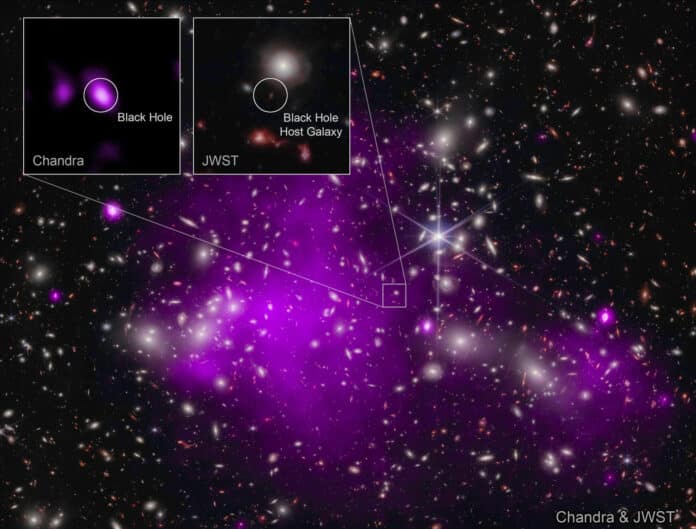Within 470 million years of the Big Bang, researchers discovered the telltale evidence of a growing black hole by merging data from NASA‘s Chandra X-ray Observatory and NASA’s James Webb Space Telescope. This black hole is the most distant that X-rays have yet to show.
The black hole is in a previously unheard-of early growth stage where its mass is comparable to that of its host galaxy. It is found in the UHZ1 galaxy, in the direction of the galaxy cluster Abell 2744, located 3.5 billion light-years from Earth. Webb data, however, has revealed the galaxy is much more distant than the cluster, at 13.2 billion light-years from Earth
Then, during two weeks of Chandra scans, it was discovered that this galaxy had a strong, superheated plasma that emitted X-rays, a sign of a developing supermassive black hole. Due to gravitational lensing, intervening matter in Abell 2744 magnifies the X-rays from gas surrounding the supermassive black hole and the light from the galaxy by a factor of four. This increases the infrared signal that Webb discovered and enables Chandra to detect the small X-ray source.
Understanding how some supermassive black holes might achieve enormous masses shortly after the Big Bang is made easier with the help of this finding.
Andy Goulding of Princeton University said, “There are physical limits on how quickly black holes can grow once they’ve formed, but ones that are born more massive have a head start. It’s like planting a sapling, which takes less time to grow into a full-size tree than if you started with only a seed.”
Strong evidence that the recently discovered black hole was born huge has been found by Bogdan’s team. According to estimates of the brightness and energy of the X-rays, its mass is between 10 and 100 million Suns. In sharp contrast to black holes in the centers of nearby galaxies, which typically contain barely a tenth of a percent of the mass of the stars in their host galaxy, this mass range is similar to that of all the stars in the galaxy where it lives.
Co-author Priyamvada Natarajan of Yale University said, “We think that this is the first detection of an ‘Outsize Black Hole’ and the best evidence yet obtained that some black holes form from massive clouds of gas. For the first time, we are seeing a brief stage where a supermassive black hole weighs about as much as the stars in its galaxy before it falls behind.”
Astronomers are now planning to use this and other results pouring in from Webb and those combining data from other telescopes to fill out a larger picture of the early universe.
Journal References:
- Akos Bogdan, Andy Goulding, Priyamvada Natarajan, Orsolya Kovacs, Grant Tremblay, Urmila Chadayammuri, Marta Volonteri, Ralph Kraft, William Forman, Christine Jones, Eugene Churazov, Irina Zhuravleva. Evidence for heavy seed origin of early supermassive black holes from a z~10 X-ray quasar. Nature Astronomy. DOI: 10.48550/arXiv.2305.15458
- Andy D. Goulding et al., UNCOVER: The Growth of the First Massive Black Holes from JWST/NIRSpec—Spectroscopic Redshift Confirmation of an X-Ray Luminous AGN at z = 10.1, The Astrophysical Journal Letters (2023). DOI: 10.3847/2041-8213/acf7c5
